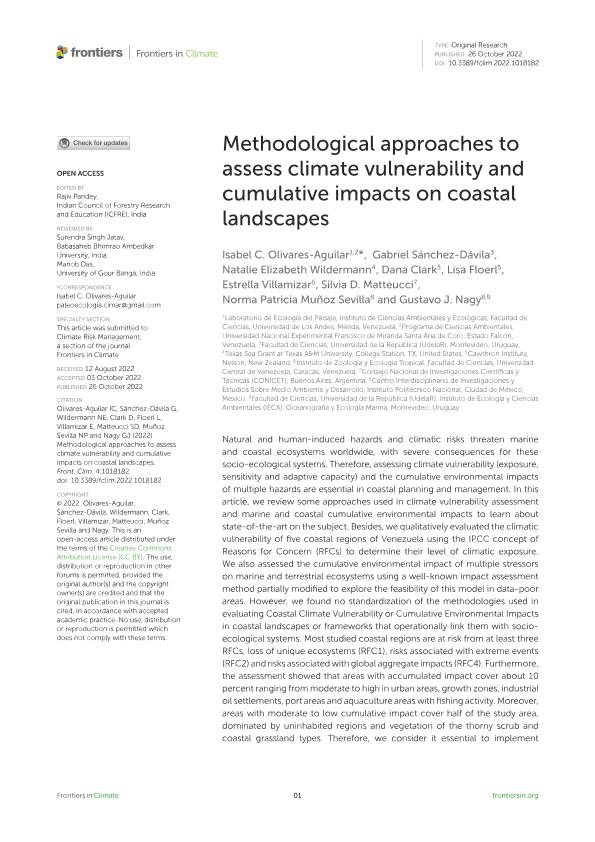Artículo
Methodological approaches to assess climate vulnerability and cumulative impacts on coastal landscapes
Abad Villamor, Ana Isabel; Sánchez Dávila, Gabriel; Wildermann, Natalie Elizabeth; Clark, Dana; Floerl, Lisa; Villamizar, Estrella; Matteucci, Silvia Diana ; Muñoz Sevilla, Norma Patricia; Nagy, Gustavo J.
; Muñoz Sevilla, Norma Patricia; Nagy, Gustavo J.
 ; Muñoz Sevilla, Norma Patricia; Nagy, Gustavo J.
; Muñoz Sevilla, Norma Patricia; Nagy, Gustavo J.
Fecha de publicación:
10/2022
Editorial:
Frontiers Media
Revista:
Frontiers in Climate
ISSN:
2624-9553
Idioma:
Inglés
Tipo de recurso:
Artículo publicado
Clasificación temática:
Resumen
Natural and human-induced hazards and climatic risks threaten marine and coastal ecosystems worldwide, with severe consequences for these socio-ecological systems. Therefore, assessing climate vulnerability (exposure, sensitivity and adaptive capacity) and the cumulative environmental impacts of multiple hazards are essential in coastal planning and management. In this article, we review some approaches used in climate vulnerability assessment and marine and coastal cumulative environmental impacts to learn about state-of-the-art on the subject. Besides, we qualitatively evaluated the climatic vulnerability of five coastal regions of Venezuela using the IPCC concept of Reasons for Concern (RFCs) to determine their level of climatic exposure. We also assessed the cumulative environmental impact of multiple stressors on marine and terrestrial ecosystems using a well-known impact assessment method partially modified to explore the feasibility of this model in data-poor areas. However, we found no standardization of the methodologies used in evaluating Coastal Climate Vulnerability or Cumulative Environmental Impacts in coastal landscapes or frameworks that operationally link them with socio-ecological systems. Most studied coastal regions are at risk from at least three RFCs, loss of unique ecosystems (RFC1), risks associated with extreme events (RFC2) and risks associated with global aggregate impacts (RFC4). Furthermore, the assessment showed that areas with accumulated impact cover about 10 percent ranging from moderate to high in urban areas, growth zones, industrial oil settlements, port areas and aquaculture areas with fishing activity. Moreover, areas with moderate to low cumulative impact cover half of the study area, dominated by uninhabited regions and vegetation of the thorny scrub and coastal grassland types. Therefore, we consider it essential to implement regional climate risk management that incorporates these assessments into the ordinance in countries that are particularly vulnerable to climate change, such as Venezuela, which has an extensive line of low-lying coastlines (where 60% of the country's population lives) and coastal regions with harsh climates and poor economic conditions. Finally, we present the scope and limitations of implementing these evaluations and highlight the importance of incorporating them into regional strategies for adaptation to climate change.
Archivos asociados
Licencia
Identificadores
Colecciones
Articulos(OCA CIUDAD UNIVERSITARIA)
Articulos de OFICINA DE COORDINACION ADMINISTRATIVA CIUDAD UNIVERSITARIA
Articulos de OFICINA DE COORDINACION ADMINISTRATIVA CIUDAD UNIVERSITARIA
Citación
Abad Villamor, Ana Isabel; Sánchez Dávila, Gabriel; Wildermann, Natalie Elizabeth; Clark, Dana; Floerl, Lisa; et al.; Methodological approaches to assess climate vulnerability and cumulative impacts on coastal landscapes; Frontiers Media; Frontiers in Climate; 4; 10-2022; 1-19
Compartir
Altmétricas



